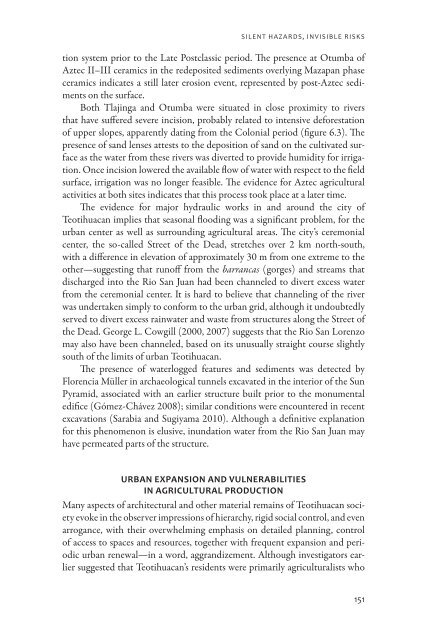free download - University Press of Colorado
free download - University Press of Colorado
free download - University Press of Colorado
Create successful ePaper yourself
Turn your PDF publications into a flip-book with our unique Google optimized e-Paper software.
Silent Hazards, Invisible Risks<br />
tion system prior to the Late Postclassic period. The presence at Otumba <strong>of</strong><br />
Aztec II–III ceramics in the redeposited sediments overlying Mazapan phase<br />
ceramics indicates a still later erosion event, represented by post-Aztec sediments<br />
on the surface.<br />
Both Tlajinga and Otumba were situated in close proximity to rivers<br />
that have suffered severe incision, probably related to intensive deforestation<br />
<strong>of</strong> upper slopes, apparently dating from the Colonial period (figure 6.3). The<br />
presence <strong>of</strong> sand lenses attests to the deposition <strong>of</strong> sand on the cultivated surface<br />
as the water from these rivers was diverted to provide humidity for irrigation.<br />
Once incision lowered the available flow <strong>of</strong> water with respect to the field<br />
surface, irrigation was no longer feasible. The evidence for Aztec agricultural<br />
activities at both sites indicates that this process took place at a later time.<br />
The evidence for major hydraulic works in and around the city <strong>of</strong><br />
Teotihuacan implies that seasonal flooding was a significant problem, for the<br />
urban center as well as surrounding agricultural areas. The city’s ceremonial<br />
center, the so-called Street <strong>of</strong> the Dead, stretches over 2 km north-south,<br />
with a difference in elevation <strong>of</strong> approximately 30 m from one extreme to the<br />
other—suggesting that run<strong>of</strong>f from the barrancas (gorges) and streams that<br />
discharged into the Rio San Juan had been channeled to divert excess water<br />
from the ceremonial center. It is hard to believe that channeling <strong>of</strong> the river<br />
was undertaken simply to conform to the urban grid, although it undoubtedly<br />
served to divert excess rainwater and waste from structures along the Street <strong>of</strong><br />
the Dead. George L. Cowgill (2000, 2007) suggests that the Rio San Lorenzo<br />
may also have been channeled, based on its unusually straight course slightly<br />
south <strong>of</strong> the limits <strong>of</strong> urban Teotihuacan.<br />
The presence <strong>of</strong> waterlogged features and sediments was detected by<br />
Florencia Müller in archaeological tunnels excavated in the interior <strong>of</strong> the Sun<br />
Pyramid, associated with an earlier structure built prior to the monumental<br />
edifice (Gómez-Chávez 2008); similar conditions were encountered in recent<br />
excavations (Sarabia and Sugiyama 2010). Although a definitive explanation<br />
for this phenomenon is elusive, inundation water from the Rio San Juan may<br />
have permeated parts <strong>of</strong> the structure.<br />
Urban Expansion and Vulnerabilities<br />
in Agricultural Production<br />
Many aspects <strong>of</strong> architectural and other material remains <strong>of</strong> Teotihuacan society<br />
evoke in the observer impressions <strong>of</strong> hierarchy, rigid social control, and even<br />
arrogance, with their overwhelming emphasis on detailed planning, control<br />
<strong>of</strong> access to spaces and resources, together with frequent expansion and periodic<br />
urban renewal—in a word, aggrandizement. Although investigators earlier<br />
suggested that Teotihuacan’s residents were primarily agriculturalists who<br />
151





